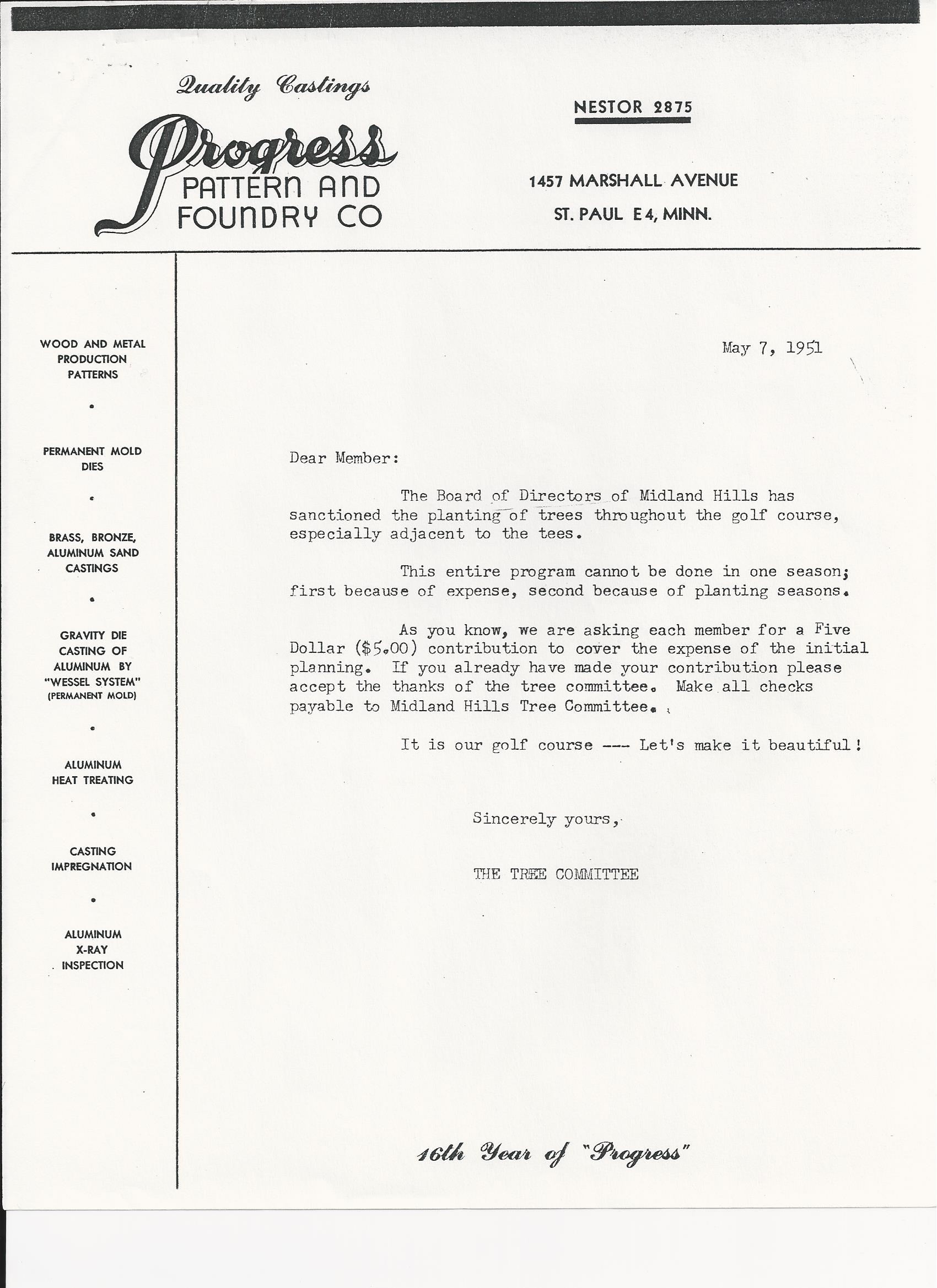2023 was the end of the Green Ash tree at Midland era. Planted en masse in the 1950s, they became the vast majority of the diversity that made up the property’s hardwood tree inventory.
They also became a large part of the identity of the property and how this golf course played on a daily basis. Ash trees were a great tree for their rapid growth, but that rapid growth came with consequences. Poor branching, suckering, and weak growth habits, they created a nightmarish messy understory – not ideal for a golf course because of the labor it took to continually clean up their mess. The Green Ash inventory in the state of Minnesota was just shy of 1 billion in 2020, so there were messes to clean throughout every county in the state. As far as inventory of Ash on Midland property, it was estimated that there were just over 1100 when it was taken professionally in 2008.

Fast forward to 2024, and there is no longer a single Ash tree on the inside of the golf course. The club hired a professional tree management company in 2008 to create a proactive management plan for current and future trees. This was at the onset of Emerald Ash Borer, which had been found for the first time in the state of MN right down the street from Midland.

For a decade we waited, as we were continually reminded that Emerald Ash Borer was coming, and when it did, it would be undeniably devastating. The club made the perfect call by creating a long-term plan to slowly remove them so that a massive expenditure wouldn’t come when the crash of the species occurred.


So in 17 years, we’ve removed approximately 900 Ash trees from the property. Some years there were more than 100 removed, to this past winter, the last 5 were taken down. This was no small task, and cannot be overstated how much effort the staff has put in to make this happen, as well as how much money we’ve saved the club (especially when you see quotes at your own homes to remove that one Ash tree in your yard for $1200. Now take that X’s 1100!) Endless winter days of dangerous work was successful because the staff had taken on the project with a professional mindset, and safety as the priority. As we knew would happen, the Emerald Ash Borer population because so large that a massive fall of the Ash species has finally occurred. Every tree that has been taken down the past 3 years has been inundated with EAB, and has met its fatal fate. Even trees that we had been treated preventatively for the insect were slowly falling victim. I’ve talked to the City of Roseville Forester many times over the past decade, and she always complimented the club for adapting a proactive approach to managing the situation. The City wasn’t as proactive, and were left scrambling over the last few years, with dead trees creating hazardous safety concerns, coupled with not enough funding to remove thousands of trees all at once.
The remaining Ash on Midland’s property are amongst the fence lines, or wooded areas around the perimeter of the property, creating an excruciating and often dangerous environment for removals. Power lines, property fences, houses, streets, and being amongst other dense stand of trees that cannot be damaged when felling, create unique challenges that take more planning, time, outside contractors and resources. In the past two winters, we’ve already removed almost 100 perimeter Ash.

Dead Ash right of 10 Approach
Tree removal has become a significant part of our department’s identity. It’s been the largest objective in the “off-season” for almost two decades. Dropping the trees, chipping the branches, logging the tree out was only half the work. Grinding the stump, cleaning it out, grinding what you missed (the first few times over) again, cutting a sod ring out around it, filling the hole with soil, packing it properly, seeding it, covering it with seed blanket, then keeping it wet via irrigation programs and even sometimes hand watering it because of a lack of irrigation coverage, feeding it, hand mowing it while its juvenile, to eventually spot seeding weak areas until it was “grown in.” Many times this process with 100+ trees in a season would take until July to completely grow in. The club also made the absolute correct call in allowing us to seed the stump holes instead of demanding that they were sodded. We worked with a local seed distributor to create a blend of seed that matched our 100 year old rough from a color standpoint. So now, you are not looking at hundreds of crop circles of sod as a reminder of where every tree used to be. That long-term vision has left us with such a better end product.

Architect Jim Urbina Studying Vistas, Presentation, and Strategy
There have also been a few newer trees that have had to be removed. When they were planted, they were in the correct locations. However, when the fairways were widened back out in the Golf Course Restoration, those trees were now much to close to the fairway and their canopies, if left to mature, would over hang the fairways, and be a detriment to the health of the turf that you play the game upon.
Then there are trees that prevent the turf from performing at its highest potential. The front of four green has never been strong, couple that with concentrated foot traffic entering/exiting the green complex, and the turf never performed at the level of the rest of the green/course. The Silver Maple not only littered the green with Sumera seeds each spring – creating a maintenance nightmare, and an even worse playing experience, but kept the turf in the shade for the first three hours of the day. Morning sunlight is the most crucial light for highly maintained turf.

Removing this tree will also allow us to have the tees on the left side of the box, to a left pin, something we couldn’t do before. Being able to utilize all of the architectural variety on this hole is a great improvement to the challenge and enjoyment.


Then there are the trees that we never want to lose because they are mature, native, properly placed specimens that highlight the property. A large American Elm was removed this winter between 11 and 17, after slowly declining over the past 10 years. These kinds of trees are always difficult to remove because they are such a big part of the “new” identity of Midland. But we know that everything that’s alive cannot live forever, and we plan for the future.

Large Rotting Limb that Fell after a 2023 Storm


As the property has taken on many levels of transformations, we now have restored a “Sporty Golf Links” classic course presentation, much closer to that of the 1921 vision. Not only does it have a classic aesthetic, but it also plays that way, with firmer conditions, and wind being a large factor in the daily variety affecting play.



Mike Manthey


Beauty is in the eye of the beholder. This beholder’s eye says the golf course gets more beautiful every year, as the ashes and other misplaced trees come down.
Thanks to you and your crew for all of your hard (and hazardous) work.
Indeed it is Dan.
Thanks for the support!
M.
Good summary/discussion
Thanks Norm!
M.
Mike –
Love all the history!
Great job (as always), this is such great info.
Hope this Spring provides you with some stress-free opportunities to prep for the upcoming season.
See ya soon!
Steve!
Thanks for reading. Spring is always exciting, this one is just a little unconventional!
Excited to see everyone (hopefully sooner than later)
M.
Yesterday three members—Emily Blodgett, Charlie Nauen, and I—played a very nice course in Palm Springs. Twice during the round there were favorable comments about the Midland Hills greens staff. Your good work is top of mind, even 2000 miles away. Thank you! David Lillehaug
Thanks guys! Really appreciate that, makes the hard work worth it! I will pass along those comments to the staff.
M.
Thank you grounds crew!! And thank you for all the history, Mike. Fascinating as always.
RIP 11/17 American Elm. She was a beaut. What’s the outlook of the big boy on no. 12 box?
Thanks for the support Jared!
Was really tough to see that Elm decline and eventually come down.
Great queastion re Elm at 12 tee. It’s doing well. When you play 12 this Spring, check out the branching crotch. So much water ends up flowing into the main trunk, because the tree was not properly pruned for its first few decades. This makes it vulnerable to rot. Regardless, let’s hope that tree lives for another 100 years!
M.
That picture with the lush green forest surrounding each hole reminds me of why it was important to not miss any fairway when playing the course in the early 90’s when I caddied, worked in the bag room, and was neighbor of head pro. The one advantage was you could 4 putt the fourth green without people on 7 tee watching you 4 putt. There was a tree in the middle of the practice green at one point, the tree committee must’ve been devastated when they lost that tree….
Steve we still hit that tree trunk in the putting green with our deep-tine aerifier! So the legacy lives on…..
M.
I was a member there in the 1980s always thought it was the most underrated course in minn. When they had amateur there they seldom broke par. Was on greens committee and we plugged and sanded the greens every other month during summer . Members hated it but we had the best greens in the state . Left to join WBYC but never lost my love of midland . Knew Wally Mund in fact was there the day he passed away while putting on 16. Jim man this gave me lessons Really like Urbina and looking at the bunkers and the treeless landscape look forward to coming. back and playing there. Urbina did a great job. I worked with him while he redid WHite Bear where he also was fabulous .I belong to a Raynor track in Florida mountain lake. Great course.
Thanks for the note Richard! Love all the background info and I really hope you make it back to play!
I’ve been to Mt Lake, love what Brian Silva had done and looking forward to seeing what the future holds for the club.
Best,
M.